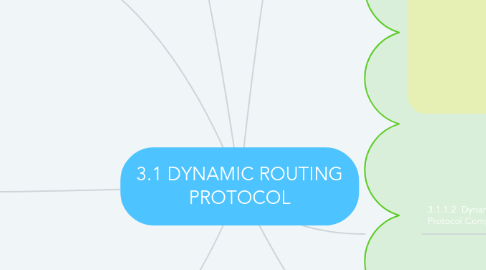
1. 3.1.2.1Static Routing Uses
1.1. Static routing has several primary uses
1.1.1. Providing ease of routing table maintenance in smaller networks that are not expected to grow significantly.
1.1.2. Routing to and from a stub network, which is a network with only one default route out and no knowledge of any remote networks.
1.1.3. Accessing a single default route (which is used to represent a path to any network that does not have a more specific match with another route in the routing table).
2. 3.1.2.2 Static Routing Advantages and Disadvantages
2.1. ADVANTAGES
2.1.1. Easy to implement in a small network.
2.1.2. Very secure, No advertisements are sent as compared to dynamic routing protocols.
2.1.3. Route to destination is remain the same always.
2.1.4. No routing algorithm or update mechanism required.
2.2. DISADVANTAGES
2.2.1. Suitable only for simple topologies or special purpose
2.2.2. Manual intervention required to re-route traffic.
2.2.3. Configuration complexity increases dramatically as network grows.
2.2.4. They are not easy to implement in a large network.
3. 3.1.2.3 Dynamic Routing Protocols Uses
3.1. Dynamic routing protocols help the network administrator manage the time-consuming
3.2. Exacting process of configuring and maintaining static routes.
3.3. Dynamic routing is the best choice for large networks like the one shown.
4. 3.1.2..4 Dynamic Routing Advantages and Disadvantages
4.1. ADVANTAGES
4.1.1. Suitable in all topologies where multiple routers are required.
4.1.2. Automatically adapts topology to reroute traffic if possible.
4.1.3. Generally independent of the network size.
4.1.4. Automatically adapts topology to reroute traffic if possible.
5. A primary benefit of dynamic routing protocols is that routers exchange routing information when there is a topology change.
6. 3.1.1.1 Dynamic routing protocol evolution
6.1. First routing protocols was RIP.
6.2. The RIP protocol updated to RIPv2 to accommodate growth in the network environment.
6.3. two advanced routing protocols were developed:
6.3.1. Open Shortest Path First (OSPF)
6.3.2. Intermediate System-to-Intermediate
6.4. Border Gateway Protocol (BGP) is used between Internet service providers (ISPs).
6.5. BGP is used between ISPs and their larger private clients to exchange routing information.
6.6. The new versions of the IP routing protocols have been developed to support the communication based on IPv6 .
7. 3.1.1.2 Dynamic Routing Protocol Components
7.1. Routing protocols used to facilitate the exchange of routing information between routers.
7.2. A routing protocol is a set of processes, algorithms, and messages that are used to exchange routing information
7.3. There are four purpose of dynamic routing protocols:
7.3.1. Discovery of remote networks
7.3.2. Maintaining up-to-date routing information
7.3.3. Choosing the best path to destination networks
7.3.4. Ability to find a new best path if the current path is no longer available
7.4. There is three main components of dynamic routing protocols
7.4.1. Data structures is function as tables or databases for its operations. This information is kept in RAM.
7.4.2. Routing protocol message is use various types of messages to discover neighboring routers, exchange routing information, and other tasks to learn and maintain accurate information about the network.
7.4.3. Algorithm use algorithms for facilitating routing information and for best path determination.
